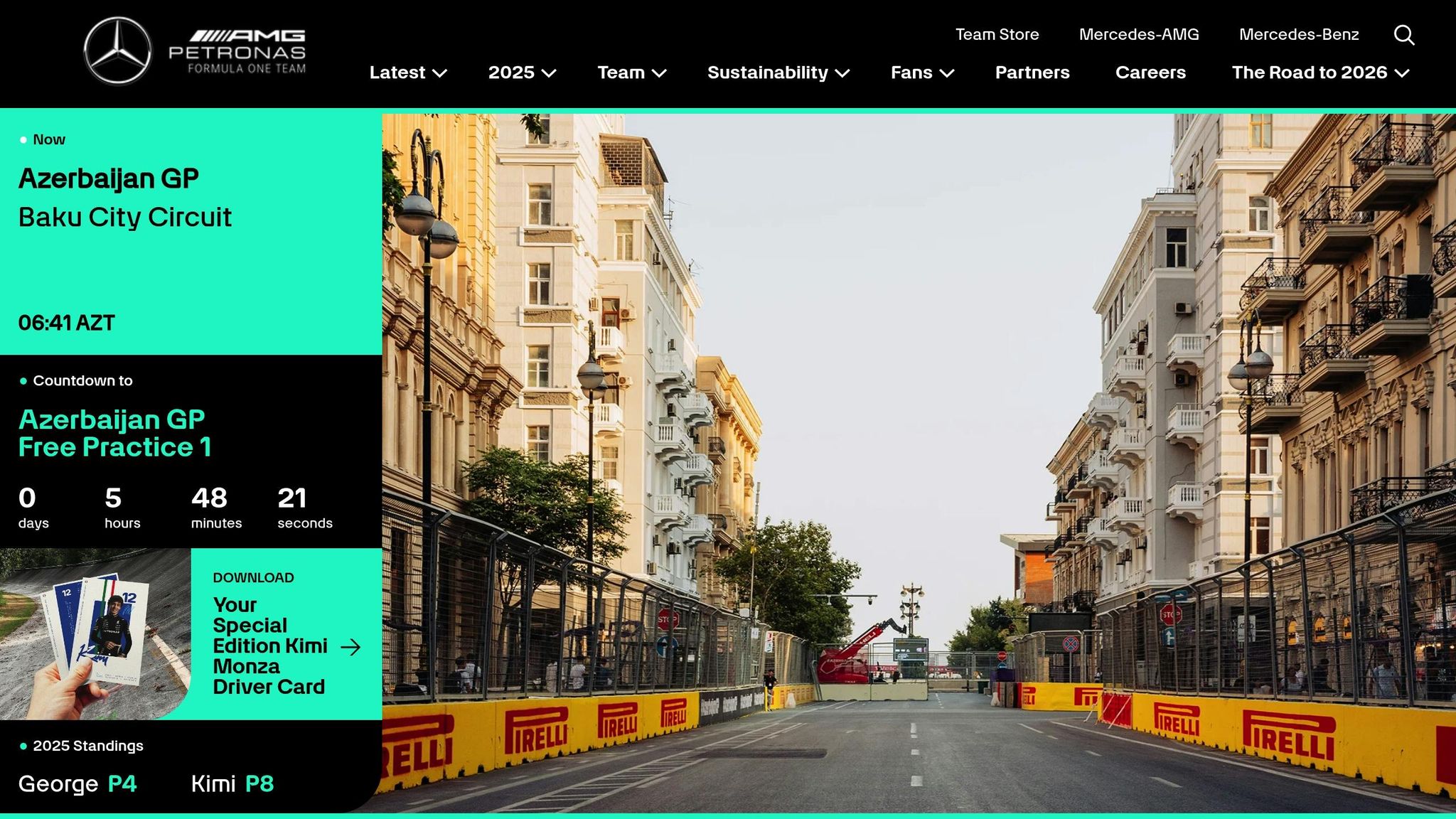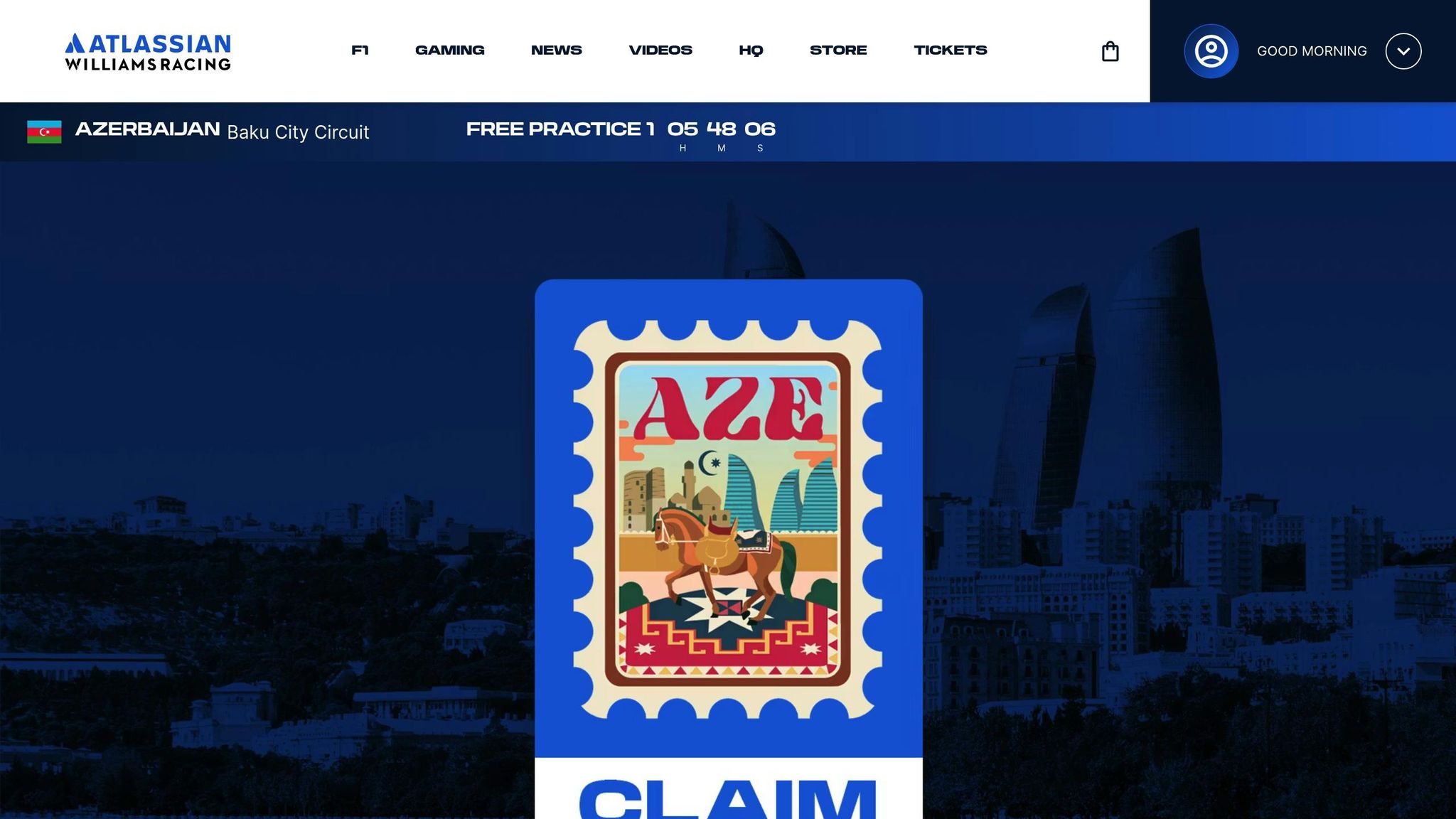Data-Driven Resource Allocation in F1 Teams
Explore how F1 teams enhance performance through data-driven resource allocation, advanced analytics, and strategic partnerships amid strict budget caps.

Formula One teams are leveraging data to gain an edge in a sport where fractions of a second matter. By integrating advanced analytics, AI, and machine learning into their operations, teams like Mercedes, Red Bull, Ferrari, and Williams optimize performance while adhering to strict budget caps. Here's a quick breakdown of how each team uses data to allocate resources effectively:
- Mercedes: Uses predictive models, digital twins, and partnerships for real-time telemetry and resource management. Their Brackley data center powers simulations and live analysis to refine strategies.
- Red Bull: Relies on Oracle Cloud for billions of simulations, generative AI for regulatory analysis, and tools to enhance manufacturing precision. They focus heavily on operational efficiency under budget constraints.
- Ferrari: Partners with AWS to replace costly hardware sensors with AI-driven solutions, reducing costs and improving car performance. Machine learning drives decisions across engineering and race strategies.
- Williams: Invests in SciML (Scientific Machine Learning) for faster simulations and predictive modeling. Strategic partnerships with companies like Atlassian and Brillio improve team efficiency and decision-making.
Each team balances cutting-edge technology, partnerships, and predictive tools to stay competitive. Success in modern F1 hinges on making informed, data-driven decisions quickly and effectively.
Visually driven data science and analytics - in Formula 1 and beyond
1. Mercedes

Mercedes blends cutting-edge infrastructure, key partnerships, predictive technology, and real-time resource management to drive its technical progress.
Technical Infrastructure
At the heart of Mercedes' operations is its Brackley data center, which handles massive amounts of data collected during race weekends. High-performance clusters power simulations like CFD (Computational Fluid Dynamics) and live telemetry analysis. With sensors installed on their cars, the team gathers detailed performance metrics, helping engineers evaluate tire behavior and aerodynamic efficiency under various track conditions - prioritizing insights that align with their development goals.
Strategic Technology Partnerships
Mercedes enhances its capabilities through collaborations with leading tech companies. A partnership with a major cloud computing provider bolsters their ability to perform advanced data analytics, while another alliance focuses on real-time data streaming and analysis during races. These collaborations ensure the team has access to both historical and live data, enabling well-informed decisions.
Predictive Modeling Methods
To stay ahead, Mercedes employs machine learning algorithms that analyze historical data and forecast the best ways to allocate resources for development. Predictive models help refine aerodynamics and power unit performance, while Monte Carlo simulations are used to plan race strategies. These simulations consider factors like tire wear, fuel usage, and weather conditions to optimize pit stops and overall race performance.
Resource Distribution Optimization
Mercedes relies on proprietary software to manage resources dynamically, allowing team leaders to monitor budgets and adjust allocations as needed. By using digital twins and workforce analytics, they can test configurations virtually and adapt staffing plans to align with current development priorities.
2. Red Bull
Red Bull Racing has built an impressive data-driven framework by combining Oracle's cloud technology with advanced manufacturing tools. This approach enhances performance while staying within Formula One's strict cost cap guidelines.
Technical Infrastructure
Red Bull utilizes Oracle Cloud Infrastructure (OCI) to perform billions of simulations during race weekends. These efforts delivered a 25% speed improvement in 2021, with an additional 10% boost achieved in 2025. The team adopted OCI Compute A2 and A4 Flex shapes for the 2025 season to secure these gains.
At the trackside, operations now run on a unified Oracle environment, employing standardized tools to streamline race activities. This setup eliminates redundancy, enabling IT teams to work seamlessly from the factory, the track, or remotely.
Strategic Technology Partnerships
Red Bull's collaboration with Oracle extends beyond cloud computing into full-scale operational management. In June 2025, the team adopted the Oracle Fusion Cloud Applications Suite, which includes Enterprise Performance Management (EPM) and Human Capital Management (HCM). These systems replaced manual spreadsheet processes with integrated analytics for finance and HR.
Red Bull also partners with Hexagon to enhance precision in manufacturing. Hexagon's 3D laser scanning and metrology tools, such as the Absolute Arm, QUINDOS software, and Leica Absolute Tracker AT960, allow for highly accurate measurement of car components.
"Since the start of our partnership, Oracle has given us a technical advantage that has helped us win races, championships, and fans. Performance gains are the lifeblood of competition in F1, and Oracle Cloud Infrastructure is the best choice to help us reach our goals on the track. From the factory to the podium, Oracle Cloud and AI technologies continue to provide the insights that help make Oracle Red Bull Racing one of the most successful teams in Formula One history." – Christian Horner, CEO and Team Principal, Oracle Red Bull Racing
These collaborations also enable Red Bull to develop advanced predictive tools that enhance decision-making during races.
Predictive Modeling Methods
For the 2025 season, Red Bull Racing is piloting a generative AI system at the pit wall. This technology combines retrieval-augmented generation (RAG) with a large language model to analyze thousands of pages of historical regulatory rulings. It provides real-time responses, helping the team contest penalties within the critical 30-minute post-race window.
Meanwhile, Red Bull Ford Powertrains uses OCI to run complex simulations for designing its next-generation sustainable fuel engine, set for the 2026 season.
These predictive tools play a key role in how Red Bull allocates resources effectively.
Resource Distribution Optimization
In line with Formula One's focus on efficiency, Red Bull uses cloud-based solutions to maximize value within the $140 million budget cap. Matt Cadieux, Chief Information Officer at Oracle Red Bull Racing, noted:
"With a fixed annual cost cap that we can't exceed, we need to make every resource go further and manage our operations as efficiently as possible. With Oracle Fusion Applications, we can take advantage of the cloud and latest advancements in predictive, generative, and agentic AI to optimize financial planning activities, accelerate business insights, and derive more value and performance from our operating budget."
Red Bull's quality control processes have also seen substantial improvements. Thanks to Hexagon's scanning technologies, the team has cut faults by 50% over the last two years while managing over 20,000 car design changes each season. Mike Hughes, Head of Quality Assurance and Manufacturing Engineering, shared:
"With Hexagon's help, we've managed to reduce our faults by 50% over the last two years."
3. Ferrari

Ferrari has teamed up with Amazon Web Services (AWS) to bring artificial intelligence and machine learning into its resource management game. This data-focused strategy boosts performance while keeping costs in check, reflecting a larger Formula 1 trend where advanced analytics drive nearly every decision.
Technical Infrastructure
At the heart of Ferrari's operations is AWS cloud computing, which powers complex neural network models. One standout example is their use of AI to emulate virtual ground speed sensors, replacing $10,000 hardware units. This not only trims costs but also helps reduce the car's weight, a critical factor in racing.
Ferrari’s AI modeling team uses large-scale computing resources to simulate and fine-tune optimal setups for each race weekend, ensuring they’re always prepared for the unique demands of every track.
Strategic Technology Partnerships
Ferrari’s partnership with AWS is about more than just technology - it's a way to access cutting-edge computing power and machine learning tools without the massive expense of building them in-house. This collaboration allows Ferrari to channel more of its resources into aerodynamic advancements and overall car performance, areas that directly impact their competitiveness on the track.
Predictive Modeling Methods
Ferrari uses machine learning to complement the expertise of its engineers. These predictive models help guide decisions on resource allocation and performance optimization, spanning areas like engineering, aerodynamics, and race strategy. By combining human insight with AI precision, the team ensures no opportunity for improvement is overlooked.
Smarter Resource Allocation
AI and machine learning have reshaped how Ferrari distributes its resources. By replacing costly physical sensors with software-driven solutions, they free up budget to focus on enhancements that directly improve lap times and race outcomes. This targeted use of resources ensures that every engineering hour and development dollar is spent where it matters most, a necessity under Formula 1's strict budget caps.
4. Williams

Williams has recently embraced a digital overhaul and formed strategic tech partnerships, sharpening its resource allocation and data-driven decision-making. These efforts have significantly boosted the team’s competitiveness.
Technical Infrastructure
Williams partnered with JuliaHub to develop its SciML infrastructure, making significant strides in simulation technology. In October 2024, the implementation of JuliaSim introduced digital twins and predictive models, resulting in a staggering 169x acceleration in aeromap simulations and a 7% improvement in accuracy.
JuliaSim’s cloud-native design brought transformative speed gains across critical simulations. For example, tire deformation modeling achieved over 1,000x faster results in quasi-static PDEs and an 8x speed boost in dynamic simulations, all while utilizing 2.3x higher-fidelity geometry. These advancements have laid a solid groundwork for Williams to enhance resource management and streamline operations.
Strategic Technology Partnerships
In 2025, Williams secured several pivotal technology partnerships that further supported its transformation:
- Atlassian: On February 12, 2025, Atlassian became the Official Title Partner, rebranding the team as Atlassian Williams Racing. Atlassian provided advanced collaboration and project management tools to enhance team efficiency.
- Brillio: Joining on March 13, 2025, as the Official Digital Transformation Partner, Brillio brought expertise in data engineering, AI services, platform engineering, and cloud infrastructure. This partnership focuses on seamless team connectivity and automating complex decision-making processes across technical and operational divisions.
- Airia: Just ahead of the 2025 Miami Grand Prix, Airia became the Official AI Orchestration Partner, offering secure, scalable AI deployment and management tools. This collaboration empowers Williams to implement AI solutions across various departments while ensuring strong security and governance.
Predictive Modeling Methods
Williams has adopted advanced SciML techniques to build digital twins, which replace physical sensors. This reduces weight and minimizes aerodynamic penalties without compromising data accuracy. In October 2024, the team developed a digital twin for a physical sensor using neural network architecture. The model captures high-frequency features and integrates known physical relationships, enabling more precise predictions.
"Scientific machine learning empowers us to predict complex system behaviours even from imperfect data, giving us the foresight that's critical in high-stakes engineering." - Selin Tur, Managing Director & Chief Technology Officer, Williams Grand Prix Technologies
These predictive models combine AI precision with human expertise, enabling faster and more reliable simulations. From optimizing aerodynamic setups to refining tire strategies, these tools allow engineers to make informed decisions quickly during race weekends. This integration of AI and human insight underscores Williams’ commitment to a data-driven approach.
Smarter Resource Allocation
Williams has redefined its approach to resource distribution by leveraging AI to connect teams with knowledge and insights more efficiently. Through its partnership with Airia, the team has automated complex task management, significantly improving decision-making speed across departments.
"Partnering with Airia is another key milestone in Atlassian Williams Racing's data and AI strategy. Their innovative AI orchestration platform and commitment to excellence, agility and continuous improvement will help give us a competitive edge in a sport where every millisecond matters." - Sorin Cheran, Chief Information and Analytics Officer, Atlassian Williams Racing
This integration of automated tools with resource strategies ensures that Williams operates with agility and precision, aligning technical operations with broader team goals. Beyond technology, Williams also invests in future talent through STEM outreach programs. This focus on nurturing skilled personnel highlights their understanding that success requires both cutting-edge innovation and a strong talent pipeline.
Pros and Cons
In Formula 1, data-driven resource allocation plays a central role in achieving peak performance. However, public insights into how each team approaches this are limited. Teams rely on analytics, simulations, and strategic collaborations to gain an edge, but every method comes with its own set of trade-offs. These differences highlight how teams balance the dual demands of speed and precision in unique ways.
- Established teams often benefit from robust, data-rich systems that have been refined over time. However, these legacy infrastructures can sometimes slow down their ability to innovate quickly.
- Teams that prioritize flexibility and operational agility can adapt more effectively to changing race conditions by using advanced technologies and external expertise. On the flip side, smaller in-house operations may struggle to maintain comprehensive, long-term analytical capabilities.
- Investing in modern infrastructure provides teams with powerful analytical tools, but integrating these complex systems can sometimes reduce responsiveness in high-pressure situations.
- Teams that lean on external partnerships to adopt new simulations and improve efficiency can speed up innovation. Yet, this reliance may leave them vulnerable if those partnerships shift or dissolve.
These pros and cons reveal the strategic balancing act every team faces. Success ultimately depends on finding the right mix of dependable systems and the agility to innovate when it matters most on the track.
Conclusion
Looking at how Mercedes, Red Bull, Ferrari, and Williams approach resource allocation, it's clear that data-driven strategies are shaping the competitive landscape in Formula One. Each team has carved out its own path, leveraging data in unique ways to maximize performance.
Mercedes relies heavily on historical data and a disciplined allocation process to maintain its dominance. Red Bull, on the other hand, channels significant resources into aerodynamic advancements and cutting-edge simulation technologies, paired with real-time data analysis. This focus on innovation has been a key factor in their recent championship successes. Ferrari blends AI modeling with traditional computational fluid dynamics (CFD), pouring considerable investment into wind tunnel testing to enhance their decision-making. Meanwhile, Williams adopts a leaner approach, leveraging strategic partnerships and prioritizing cost-efficient data solutions to remain competitive despite smaller budgets.
These approaches highlight the role of integrated data systems as a critical asset throughout the F1 season. Teams that master the balance between long-term infrastructure investment and the ability to pivot resources based on real-time insights tend to outperform those with more rigid strategies. The top-performing teams use data not just as a tool but as a driving force behind every significant resource decision.
In today's Formula One, the ability to interpret data quickly and adjust strategies on the fly has become as crucial as the raw speed of the cars. This analysis underscores that success in modern F1 hinges on agile, data-driven decision-making.
FAQs
How do F1 teams like Mercedes and Red Bull balance advanced technology with staying under the $135 million budget cap?
F1 teams like Mercedes and Red Bull keep their operations within the $135 million budget cap by leveraging advanced, data-driven strategies and smart resource management. They use tools such as telemetry, simulations, and analytics to fine-tune their development processes and boost performance without exceeding financial limits.
To get the most out of their budgets, these teams emphasize efficient innovations and carefully prioritize how resources are allocated. For instance, they limit wind tunnel testing and streamline data analysis workflows to save costs. This method allows them to meet budget regulations while staying highly competitive on the track.
How do strategic technology partnerships influence data-driven decisions in F1 teams like Ferrari and Williams?
Strategic technology partnerships are a key factor in how Formula One teams like Ferrari and Williams sharpen their data-driven decision-making. These alliances offer access to advanced tools, sophisticated analytics platforms, and specialized knowledge that elevate how teams analyze performance and allocate resources.
With these partnerships, teams can handle enormous volumes of data - covering everything from telemetry to aerodynamics and tire performance - much more efficiently. This allows them to make smarter choices about race strategies, car development, and even real-time tweaks during races, giving them an edge where it matters most: on the track.
How do predictive modeling and AI technologies enhance race strategies and performance in Formula One?
Predictive modeling and AI technologies have become game-changers in shaping race strategies in Formula One. These advanced tools help teams predict crucial factors like weather conditions, tire degradation, and fuel consumption. With this data, teams can make well-informed decisions, such as determining the optimal timing for pit stops or tire changes - choices that can heavily influence the outcome of a race.
AI doesn’t stop there. It processes real-time telemetry data during races, allowing teams to tweak strategies as events unfold. By spotting patterns and potential issues faster than any human could, AI enables teams to react swiftly to changing conditions on the track. This blend of precision and flexibility is redefining how F1 teams fine-tune their performance and stay ahead of the competition.




